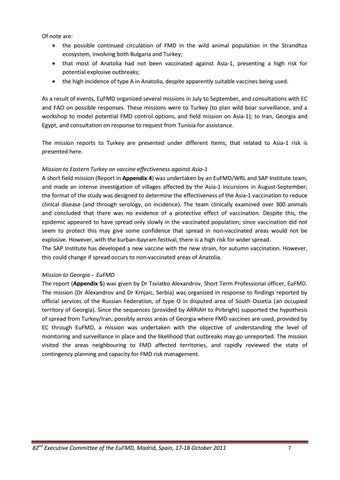Of note are: the possible continued circulation of FMD in the wild animal population in the Strandhza ecosystem, involving both Bulgaria and Turkey; that most of Anatolia had not been vaccinated against Asia-1, presenting a high risk for potential explosive outbreaks; the high incidence of type A in Anatolia, despite apparently suitable vaccines being used. As a result of events, EuFMD organized several missions in July to September, and consultations with EC and FAO on possible responses. These missions were to Turkey (to plan wild boar surveillance, and a workshop to model potential FMD control options, and field mission on Asia-1); to Iran, Georgia and Egypt, and consultation on response to request from Tunisia for assistance. The mission reports to Turkey are presented under different Items; that related to Asia-1 risk is presented here. Mission to Eastern Turkey on vaccine effectiveness against Asia-1 A short field mission (Report in Appendix 4) was undertaken by an EuFMD/WRL and SAP Institute team, and made an intense investigation of villages affected by the Asia-1 incursions in August-September; the format of the study was designed to determine the effectiveness of the Asia-1 vaccination to reduce clinical disease (and through serology, on incidence). The team clinically examined over 300 animals and concluded that there was no evidence of a protective effect of vaccination. Despite this, the epidemic appeared to have spread only slowly in the vaccinated population; since vaccination did not seem to protect this may give some confidence that spread in non-vaccinated areas would not be explosive. However, with the kurban-bayram festival, there is a high risk for wider spread. The SAP Institute has developed a new vaccine with the new strain, for autumn vaccination. However, this could change if spread occurs to non-vaccinated areas of Anatolia. Mission to Georgia - EuFMD The report (Appendix 5) was given by Dr Tsviatko Alexandrov, Short Term Professional officer, EuFMD. The mission (Dr Alexandrov and Dr Krnjaic, Serbia) was organized in response to findings reported by official services of the Russian Federation, of type O in disputed area of South Ossetia (an occupied territory of Georgia). Since the sequences (provided by ARRIAH to Pirbright) supported the hypothesis of spread from Turkey/Iran, possibly across areas of Georgia where FMD vaccines are used, provided by EC through EuFMD, a mission was undertaken with the objective of understanding the level of monitoring and surveillance in place and the likelihood that outbreaks may go unreported. The mission visited the areas neighbouring to FMD affected territories, and rapidly reviewed the state of contingency planning and capacity for FMD risk management.
82nd Executive Committee of the EuFMD, Madrid, Spain, 17-18 October 2011
7

